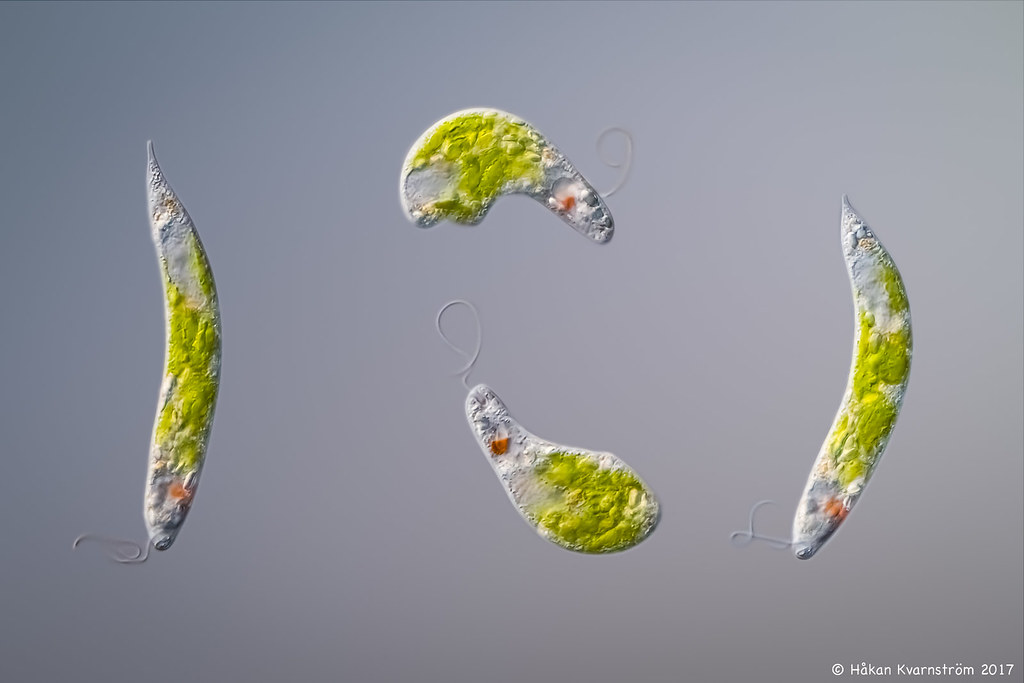Page 1 of 1
What is this organism?
Posted: Thu Sep 27, 2018 5:58 pm
by MikeBradley
I found many examples of this organism in a sample from a local marsh. The organisms are about 150 microns long , when extended, bright green, and are continuously twisting and turning, stretching and compressing. I'v attached a couple of DSLR images taken with 40x and 20x objectives. Thanks
michael
Re: What is this organism?
Posted: Thu Sep 27, 2018 7:53 pm
by hkv
Looks like Euglena. Nice shot!
Re: What is this organism?
Posted: Thu Sep 27, 2018 8:07 pm
by MikeBradley
Thanks for the reply hkv. I was never able to see flagella, so I don't think it is Euglena, it was also much larger (3x) than the Euglena I've seen before.
Thanks for the comment on the image!
Michael
Re: What is this organism?
Posted: Thu Sep 27, 2018 8:19 pm
by coominya
I have no idea myself, but I like it! I wish I had some to study.
What country are you in, what climate?
Re: What is this organism?
Posted: Thu Sep 27, 2018 9:49 pm
by 75RR
Not seen any that are as flexible as yours seem to be, so perhaps not an euglena but yes to a member of Phylum Euglenozoa
https://en.wikipedia.org/wiki/Euglenozoa
Re: What is this organism?
Posted: Thu Sep 27, 2018 9:50 pm
by actinophrys
I will second hkv here. Euglena vary a great deal in size; some species are as small as 20 µm or so, while for instance E. ehrenbergi can reach 400 µm in length. Especially in these longer types, movement is often by metaboly – flexing and changing shape – and the flagellum is then often short and harder to see.
If not a Euglena proper this would have to be some close relative, as shown by the typical euglenoid form and eyespot. There are now a number of genera that are hard to tell apart, but I'm not sure that any others get so large except Lepocinclis, which are more rigid.
Re: What is this organism?
Posted: Fri Sep 28, 2018 3:39 am
by MikeBradley
Thanks everyone for the Euglena suggestion, I now think that's what they are. I researched further and found a video of E.mutabilis on the Euglena Wikipedia page, it certainly looks very similar in size, shape, colour and movement to the properties of my specimens. I re-sampled my source and really tried to find evidence of flagella - no luck. Then I "stretched" all of my dozens of images in Photoshop to enhance fine details - still no luck finding the flagella. I'm attaching a shot of eyespot area (40x objective/DSLR) to this post to illustrate this.
Thanks everyone,
Michael
Re: What is this organism?
Posted: Fri Sep 28, 2018 5:03 am
by 75RR
Flagella are in general very difficult to see in Brightfield. A good reason to add Phase Contrast to one's wish list.
Re: What is this organism?
Posted: Fri Sep 28, 2018 8:24 pm
by hkv
The flagella are also clearly visible using DIC.
 Euglena
Euglena by
Håkan Kvarnström, on Flickr
Re: What is this organism?
Posted: Fri Sep 28, 2018 9:20 pm
by Bruce Taylor
still no luck finding the flagella
Not all species of
Euglena have emergent flagella. One that does not is the common species
Euglena mutabilis, which (as you've already noted) resembles your euglenid, but is typically a bit smaller. Another is
E. carterae (=
E. deses var. carterae).
Also, some euglenids readily shed their flagella, particularly when dividing, or under stress (a process called
flagellar autotomy).
